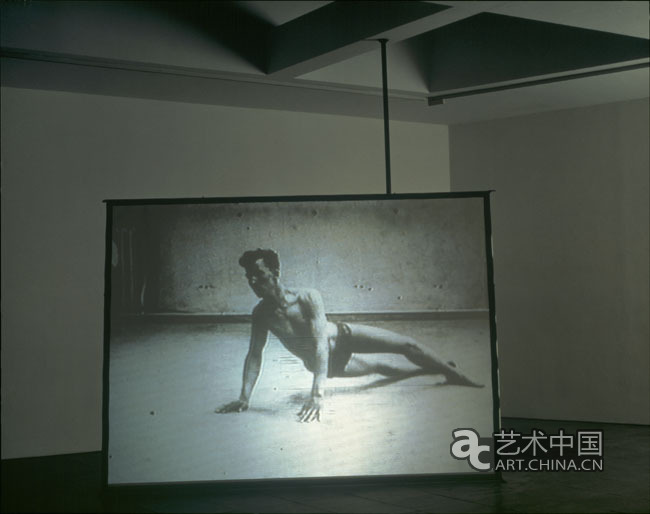道格拉斯戈登《10米/秒》 |
| 艺术中国 | 时间: 2010-01-29 18:39:20 | 文章来源: 艺术中国 |
|
道格拉斯戈登《10米/秒》 Douglas Gordon 10 ms-¹ 1994 Video installation, 10 minutes 26 seconds Dimensions variable 道格拉斯.戈登 10米/秒,1994 录像装置 10分26秒 尺寸变量
在道格拉斯•戈登10 ms 的发泡光银胶片前,人们的目光很难从痛苦、迟缓的框中人身上挪开。一面硕大斜屏上的无声、循环视频投影刻画了一个男人,他几乎是以芭蕾舞中的潜水动作落向地面,然后似乎无法爬起。他试图站立的笨拙尝试令人沮丧和感伤。场景艰难而凄凉—人们可以看出右手边似乎放着一张硬板床。他只穿着内衣,这增加了他的脆弱性;他苍白、无力的肢体似乎在阻挠他千方百计站起身。这件作品是《24小时惊魂记》(24 Hour Psycho)(1993年)1的延续,后者也进行了慢动作处理,可能是戈登最著名的作品。不过,尽管用了与阿尔弗雷德•希区柯克的《精神病患者》(Psycho)(1960年)相似的典型材料,10 ms 如此成功的部分原因,是因为其源脚本不为人知。 大型投影使我们感受到了人物的真实。屏幕的倾斜,在某种程度上打破了我们的自身平衡,所以我们能接近画面中的人物,对他的窘境感同身受。该名男子显然处于苦难之中,从而激起了我们的怜悯和同情。不过,一次又一次的尝试和失败开始折磨我们,这种不适促使我们考虑所看到的一切。沉浸在无休止的站立和失败循环中,我们的思想在他身上游离。他看起来是那么健康,我们开始怀疑哪里出了错。我们可以发现,所能找到的脚本可以追溯到第一次世界大战,这为我们的解读增添了一层新的感伤和历史厚重感。那么,这是个心理问题吗?是由战争恐惧或炸弹休克诱发的疯狂吗?为什么现场有一台摄影机对他拍摄,而没有一个人去帮助他?我们可能会想到这个事件是表演——一个医疗文件或教学视频。 事实上,这段影片所激起的客观、迷幻的凝视可以称之为“医疗”。正如戈登在一次访谈中所评论的:“恐惧、排斥和魅力同是这一学科(神经心理学)和电影世界的关键要素。” 2 不久之后,戈登的另外两部特别近似的作品也提出了类似主题的讨论。《狂乱》(Hysterical)(1994-95年)3放映的是另一部引起广泛质疑的脚本片段,其中有一位年轻女子被弄得浑身痉挛,然后又恢复原样,以利于拍摄。在另一部作品模糊逻辑(1995年)4中,我们目睹了一只垂死苍蝇的最后一次抽搐动作。驱使我们观看这些令人毛骨悚然却又冷酷无情的画面的,是这些作品的核心问题所在。在每部作品中,影片的主题都是摄影机的囚徒,正如我们观众是影片的囚徒,被冷酷的镜头所禁锢。有趣的是,我们在情感上越是想和屏幕上所发生的事件决裂,我们就越是被吸引,去审视旧脚本的质感,并思考影片的内涵及其本身。正如雷蒙德•贝卢尔的简洁评论:“戈登让影片发出了这样的声音:我已经死去,但我仍然可以在此活着,来告诉你这一点。” 5这段特殊画面能使我们想起,在胶片中深藏着优秀作品,它们含有以下令人不安的信息,并决意要我们遵从:“看。看。看。” 劳拉•麦克利恩•法里斯 1《沃尔夫斯堡私人收藏和艺术博物馆》。第2版 2“吸引力-排斥”,戈登接受斯蒂法妮•莫斯顿-冬布雷采访(1996年),见道格拉斯•戈登《幻觉:问题和答案》,第1卷,1992-1996年(巴黎:巴黎市立近代美术馆,2000年),第110页 3 《南安普敦市美术馆和罗什舒阿尔当代艺术部门博物馆》。第2版。 4第3版。 5.雷蒙德•贝卢尔,“见面的瞬间”,见《道格拉斯•戈登》,cat展(里斯本:贝伦文化中心,1999年),第27页 Douglas Gordon It is hard to look away from the painfully slowed-down frames of blistered silver film in Douglas Gordon’s 10 ms−1. A silent, looped video projection on a large tilted screen depicts a man, who falls to the ground in an almost balletic dive, and then appears unable to get up. His awkward attempts to stand are frustrating and pathetic. The environment is hard and stark – one can make out what looks to be a hard bed to the right-hand side. He is wearing only underwear, adding to his vulnerability; his pale, quite useless limbs appear to thwart him as he tries different ways of getting to his feet. This work follows 24 Hour Psycho (1993) , which also employs slow-motion process, and is perhaps Gordon’s best-known work. However, whilst the material appropriated for that work, Alfred Hitchcock’s Psycho (1960), is almost archetypal, part of the reason 10 ms−1 is so effective is because the source footage is unknown. The large scale of the projection renders the figure life-sized to us. The tilting of the screen upsets our own balance somewhat, so we approach the figure in the footage as an equal, identifying with his sorry plight. The man is clearly in distress, inviting our pity and sympathy. Repeated attempts and failures, however, begin to wear on us, and discomfort provokes us to consider what we are watching. Caught in an endless cycle of build-up and failure, we separate ourselves from him. We begin to wonder what is wrong. He looks healthy enough. We might discover that the found footage dates to the First World War, adding a new layer of pathos and historical weight to our reading of what we see. Is the problem, then, psychological? Madness induced by the horrors of war, or shell-shock? Why is there a camera watching this man in the first place, and why will no-one assist him? It may occur to us that the event is staged – a medical document or training video. Indeed, the objective, fascinated gaze that this film encourages of us might be termed ‘medical’. As Gordon has commented in an interview, ‘Fear and repulsion and fascination are critical elements in both the world of this science [neuropsychology] and the world of cinema.’ Two other specifically analogous works, made by Gordon shortly after, broached similar themes. Hysterical (1994–95) features another very questionable piece of footage, in which a young woman is provoked into a fit and then restored, for the benefit of the camera. In another, Fuzzy Logic (1995) , we witness the last twitching movements of a dying fly. What impels us to watch these images, feeling horrified yet strangely cold and clinical, is the question at the core of these works. In every one, the subject of the film is a prisoner to the camera, just as we the viewer, are prisoner to the film, locked in a cold embrace. Interestingly, the more we might emotionally disconnect from what is happening on screen, the more we are drawn to examine the texture of the antique footage, and to consider film in and of itself. As Raymond Bellour has succinctly commented, ‘Gordon lends the cinema a voice that could say: I am dead but I am still alive enough to tell you this.’ What this particular piece of footage might remind us is that there is a quality deeply inherent in the fabric of film, that contains the following uncomfortable message, and wills us to obey: ‘Look. Look. Look.’ Laura McLean-Ferris |
| 注:凡注明 “艺术中国” 字样的视频、图片或文字内容均属于本网站专稿,如需转载图片请保留 “艺术中国” 水印,转载文字内容请注明来源艺术中国,否则本网站将依据《信息网络传播权保护条例》维护网络知识产权。 |
